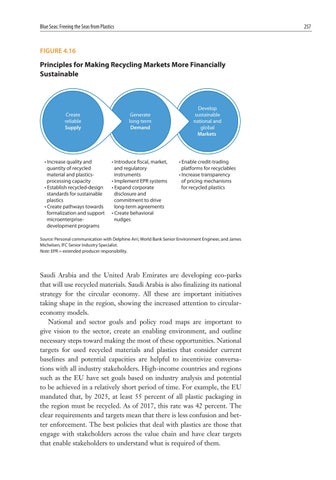Blue Seas: Freeing the Seas from Plastics
257
FIGURE 4.16
Principles for Making Recycling Markets More Financially Sustainable
Create reliable Supply
Generate long-term Demand
• Increase quality and quantity of recycled material and plasticsprocessing capacity • Establish recycled-design standards for sustainable plastics • Create pathways towards formalization and support microenterprisedevelopment programs
• Introduce fiscal, market, and regulatory instruments • Implement EPR systems • Expand corporate disclosure and commitment to drive long-term agreements • Create behavioral nudges
Develop sustainable national and global Markets
• Enable credit-trading platforms for recyclables • Increase transparency of pricing mechanisms for recycled plastics
Source: Personal communication with Delphine Arri, World Bank Senior Environment Engineer, and James Michelsen, IFC Senior Industry Specialist. Note: EPR = extended producer responsibility.
Saudi Arabia and the United Arab Emirates are developing eco-parks that will use recycled materials. Saudi Arabia is also f inalizing its national strategy for the circular economy. All these are important initiatives taking shape in the region, showing the increased attention to circulareconomy models. National and sector goals and policy road maps are important to give vision to the sector, create an enabling environment, and outline necessary steps toward making the most of these opportunities. National targets for used recycled materials and plastics that consider current baselines and potential capacities are helpful to incentivize conversations with all industry stakeholders. High-income countries and regions such as the EU have set goals based on industry analysis and potential to be achieved in a relatively short period of time. For example, the EU mandated that, by 2025, at least 55 percent of all plastic packaging in the region must be recycled. As of 2017, this rate was 42 percent. The clear requirements and targets mean that there is less confusion and better enforcement. The best policies that deal with plastics are those that engage with stakeholders across the value chain and have clear targets that enable stakeholders to understand what is required of them.






